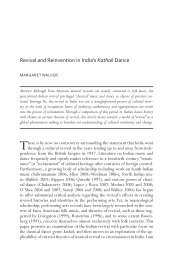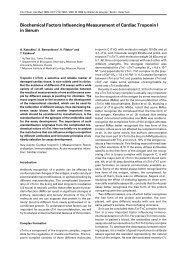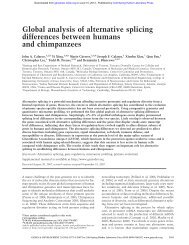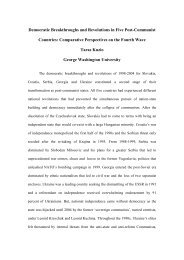The New Human Tissue Kallikrein Gene Family - Endocrine Reviews
The New Human Tissue Kallikrein Gene Family - Endocrine Reviews
The New Human Tissue Kallikrein Gene Family - Endocrine Reviews
Create successful ePaper yourself
Turn your PDF publications into a flip-book with our unique Google optimized e-Paper software.
April, 2001 THE NEW HUMAN KALLIKREIN GENE FAMILY 185“kininogenases.” <strong>The</strong> term “kininase” is used to describeother enzymes that can inactivate kinins. Among the knownhuman and animal tissue kallikreins, only one enzyme hasthe ability to release efficiently a bioactive kinin from akininogen. In humans, this enzyme is known as pancreatic/renal kallikrein or, with the new nomenclature, as the KLK1gene, encoding for human kallikrein 1 (hK1 protein) (9–12).This enzyme acts upon a liver-derived kininogen (low molwt kininogen) to release lysyl-bradykinin (also known askallidin), which is involved in the control of blood pressure,electrolyte balance, inflammation, and other diverse physiologicalprocesses. <strong>Tissue</strong> kallikrein (hK1) may further enzymaticallydigest other substrates, including growth factors,hormones, and cytokines, to mediate pleiotropic effects(7).It should be emphasized that the generic term “tissuekallikrein” is not restricted to the description of enzymes thatrelease bioactive peptides from precursor molecules. <strong>The</strong>term is used to describe a group of enzymes with highlyconserved gene and protein structure, which also share considerablesequence homology and colocalize in the samechromosomal locus as the KLK1 gene. In this review, theterm “kallikrein” will be used to describe a family of 15 genesthat have a number of striking similarities, as outlined inpoint format in Table 1 (13). <strong>The</strong> use of the term “kallikrein”does not necessarily imply that any of these family members(with the exception of KLK1) have kininogenase activity. Infact, for human family members that have been functionallytested, it was found that they possess very low (hK2) (14, 15)or no kininogenase activity [prostate-specific antigen (PSA)](14). <strong>The</strong>se enzymes are grouped together with KLK1, basedon the similarities outlined in Table 1.II. <strong>The</strong> <strong>Human</strong> and Rodent Families of<strong>Kallikrein</strong> <strong>Gene</strong>s<strong>The</strong> tissue kallikrein literature can be roughly separatedinto various periods as follows. Early in the 1920s and 30s,researchers discovered the basic components of the kallikrein-kininsystem and identified the molecular structure ofbradykinin and kallidin (lysyl-bradykinin) in the 1960s (8).<strong>The</strong> molecular biology of the tissue kallikrein gene familywas worked out in detail in both the human and rodents inthe 1980s (16–19). It was then concluded that the mouse andrat gene families were composed of many genes, clustered inthe same chromosomal locus. In particular, the mouse tissuekallikrein gene family is localized on chromosome 7 andconsists of 24 genes, of which at least 14 encode for activeproteins (the remaining being pseudogenes) (16, 20–22). <strong>The</strong>area on chromosome 7 encompassing the mouse kallikreinsis homologous to an area on human chromosome 19q13.4that harbors the human kallikrein gene family. <strong>The</strong> rat tissuekallikrein gene family is composed of approximately 20 homologousgenes of which at least 10 are expressed (18, 23–30).Most of the rodent tissue kallikreins are expressed in thesalivary glands, but a few, including the prostate, pituitarygland, and endometrium, have more diverse tissue expression(7, 9, 31–33). It is not the purpose of this review todescribe in detail the rodent or other animal tissue kallikreingene families. Excellent reviews on this subject already exist(9, 16, 17, 21, 22).<strong>The</strong> human tissue kallikrein gene family was also discoveredin the 1980s and it was then concluded that the entirefamily is composed of only three genes, namely KLK1, encodingfor pancreatic/renal kallikrein (hK1 protein), theKLK2 gene, encoding for human glandular kallikrein 2(hK2), and the KLK3 gene, encoding for PSA (hK3) (34–38).<strong>The</strong> major interest in human kallikreins lies in the very restrictedtissue expression of hK2 and hK3 in the prostate,which qualifies them as candidate biomarkers for prostaticdiseases (39–43). hK3 (PSA), in particular, has gained prominencein recent years as the most valuable tumor markerever discovered and is currently used widely for the diagnosis,monitoring, and population screening for prostate cancer(44–51). <strong>The</strong> introduction of this test has had a majorimpact on prostate cancer diagnosis and monitoring and thisfield is still evolving (52, 53). More recently, PSA applicationshave extended beyond the prostate, including breast andother cancers (54–57). Over the last few years, human glandularkallikrein 2 is emerging as an additional prostatic andbreast cancer biomarker, and it is now clear that it can supplementPSA testing for improved identification and differentialdiagnosis of prostate cancer (43, 58–66). It is thuslogical to exploit the possible applications of other membersof this gene family for cancer and other disease diagnosis andmonitoring.In the last 3 yr, we have witnessed the emergence of newknowledge related to the human kallikrein gene family (13).Independent researchers have cloned a number of new serineprotease genes that show significant homologies with theclassical human kallikreins; in addition, when these newprotease genes were mapped, they were found to colocalizein the known human kallikrein gene locus on chromosome19q13.3-q13.4 (67–90). <strong>The</strong> recent detailed molecular descriptionof the human kallikrein gene locus (67, 68) enabled usto construct a physical map containing 15 genes that shareTABLE 1. Similarities between members of the new human kallikrein gene family1. All genes localize to the same chromosomal region (19q13.4).2. All genes encode for putative serine proteases with a conserved catalytic triad (histidine, aspartic acid, and serine in the appropriatepositions).3. All genes have five coding exons (some members contain one or more 5-untranslated exons).4. Coding exon sizes are similar or identical.5. Intron phases are fully conserved among all 15 human members and among members of the rodent kallikrein gene families. a6. All genes have significant sequence homologies at the DNA and amino acid levels (40–80%).7. Many of these genes are regulated by steroid hormones.a Intron phase refers to the location of the intron within the codon: intron phase I, the intron occurs after the first nucleotide of the codon;II, the intron occurs after the second nucleotide; 0, the intron occurs between codons.
















